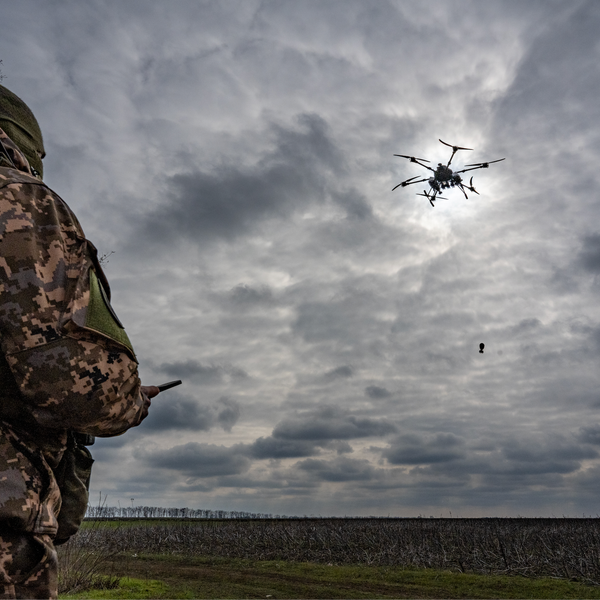OPINION — “We must prepare for a world where constraints on nuclear weapons arsenals disappear entirely, modernizing U.S. nuclear capabilities today and preparing for future posture adjustments may help incentivize our adversaries to engage in strategic arms control discussions. However, if our adversaries continue to make choices that make them and the world less safe, the United States is prepared to do what is necessary to successfully compete, to deter aggression, and assure our allies in this new nuclear age.”
That was Dr. Vipin Narang, the Acting Assistant Secretary of Defense for Space Policy, speaking last Wednesday, at the Center for Strategic and International Studies, whose Project on Nuclear Issues hosted an event for early- and mid-career nuclear experts.
At the Pentagon, Dr. Narang’s portfolio includes nuclear deterrence, and he chairs an international advisory panel to NATO’s Nuclear Planning Group. He also helped form the new Nuclear Consultative Group with South Korea. Dr. Narang is on public service leave from MIT where he served as the Frank Stanton Professor of Nuclear Security and Political Science. He is author of Nuclear Strategy in the Modern Age, and Seeking the Bomb: Strategies of Nuclear Proliferation.
Dr. Narang talked about current trends and how they are affecting future planning in more specific terms than have other Biden administration officials. On Capitol Hill and among U.S. allies in Europe and the Indo-Pacific area, there is concern about the U.S. facing two peer nuclear powers with Chinese nuclear weapon expansion and Moscow’s developing new nuclear weaponry.
“Absent a change in the nuclear trajectories of the PRC (People’s Republic of China), Russia, and North Korea, we may reach a point where a change in the size or posture of our current deployed forces is necessary,” Dr. Narang said, adding, “There is no need to grow the stockpile yet, but adjustments to the number of deployed capabilities may be necessary if our adversaries continue down their current paths.”
He also reassured his audience that, “We are confident in our current forces and posture today,” and that “we will also abide by the central limits of New START for the duration of the treaty as long as we assess that Russia continues to do so. But in an uncertain world, preserving the option to change course tomorrow requires that we make necessary decisions and investments today.”
It's not just for the President anymore. Cipher Brief Subscriber+Members have access to their own Open Source Daily Brief, keeping you up to date on global events impacting national security. It pays to be a Subscriber+Member.
It’s not as if the U.S. is standing still. Dr. Narang pointed out that pushed by Congress, the Biden administration is developing a new nuclear sub-launched cruise missile (SLCM-N) for which the Senate Appropriations Committee last week, approved $70 million in the fiscal 2025 budget.
Already in the works, is a new tactical nuclear bomb, the B61-13, designed to attack harder- protected, deeply-based or large-area targets, and is intended to replace the B61-7, which has a yield of up to 360 kilotons – the equivalent of 360 thousand tons of TNT.
I want to pause and try to explain, which is almost never done by U.S. officials when discussing nuclear weapons, what such nuclear weapons could do if they are used in warfare.
There was recently an outcry over U.S. 2,000-pound conventional bombs being delivered to Israel for its war in Gaza based on the damage such a weapon could have on the civilian population. Such a bomb contains roughly 945 pounds of explosives.
A single, one kiloton nuclear weapon contains the equivalent power of 1,000 tons of explosives and thus alone has the explosive power of 2,000 of those U.S. 2,000-pound conventional bombs – the ones the U.S. halted giving the Israelis because of the damage they would cause. And that does not include the enormous heat and long-lasting radiation such nuclear weapons also deliver.
Now think of the extensive and long-lasting, widespread damage that would result from use of one B61-13, should its full 360 kilotons ever be unleashed.
Dr. Narang also said, “The growth in the number of Chinese strategic targets alone I think, leads one to the conclusion that a modernization program sized for a completely different security environment may need to be reassessed in sort of the multiple, nuclear challenger world.”
He is referring to the idea that each silo for a new Chinese nuclear ICBM, each mobile ICBM, each strategic submarine, or nuclear-capable, strategic bomber is a target for a nuclear weapon.
That is how the need for additional nuclear weapons gets driven up, because deterrence strategy since the Cold War, has been a numbers game. To deter a nuclear-armed enemy, you had to have enough nuclear weapons to absorb a first strike, and survive with enough of your own weapons to destroy the enemy’s remaining weapons.
Of course, that is why the U.S. and the Russians have so-called triads of delivery systems – land-based ICBMs, strategic bombers and a major portion of their strategic warheads on difficult-to-find submarines, as have the British, French and Israelis. It is also why the Chinese are creating their own triad with a strategic submarine force – as are the North Koreans.
This idea of nuclear weapons only being used to attack a potential enemy’s nuclear weapons arose because neither the U.S., nor apparently the Soviet Union, wanted to appear to be using nuclear weapons to attack enemy cities because that would result in millions of civilian deaths and appear to violate traditional rules of war.
The Cipher Brief Threat Conference is happening October 5-8 in Sea Island, GA. The world's leading minds on national security from both the public and private sectors will be there. Will you? Apply for a seat at the table today.
In fact, that is exactly why atomic bombs were originally created and used — as terror weapons to kill and wound civilians and thus end the war with Japan. Hiroshima and Nagasaki had some military facilities, but they were also selected as targets because other Japanese cities had already been partially destroyed and thus, the impact of these new atomic bombs would be less dramatic.
Today’s hydrogen bombs are much more powerful than the two atomic bombs used on Japan, so why the U.S. and Russia, which already have thousands of them, would want more is among many questions about the nuclear arms race that is worth asking.
Meanwhile, Dr. Narang last week, voiced concern about “covering” nuclear weapons targets.
“As the security environment continues to deteriorate, and you have the multiple challenger problem, you don’t want to have to rely on triad or strategic forces to deter in the Indo-Pacific,” he said, “especially with the growth in Chinese forces — which would leave strategic targets uncovered.”
The answer to covering China’s non-strategic nuclear weapons, according to Dr. Narang, is “essentially a SLCM-N. It has to be – in the maritime [Indo-Pacific] environment, you can’t have forward land presence [U.S. tactical nuclear-capable fighter-bombers] in the way that we have in Europe.”
In Europe, Dr. Narang pointed out, “We’re completing the modernization of NATO nuclear capabilities through the transition to the fifth-generation F-35 [nuclear-capable, fighter-bombers] and the B61-12 [new nuclear bomb with more accuracy and limited stand-off guidance capability], which are bolstering the military effectiveness and the credibility of the deterrent.”
Dr, Narang described the SLCM-N and B61-12 as “regional capabilities, you know, primarily for regional contingencies.”
What is also underway, is examination and groundwork for, as Dr. Narang put it, “the expiration of New START, if there’s no follow-on treaty and our adversaries continue down this pathway, are we prepared – if necessary, and if the President decides to do so, do we – are we able to potentially, if required, increase the number of deployed strategic capabilities as well?”
Dr. Narang added that, “We don’t need to outpace our adversaries or even the combined number of the adversaries. We do seek a smart, flexible posture that deters, you know, at a strategic level, and assures our allies and partners.”
He went on, “It’s not an unrestrained posture. But I think we are now in the middle of thinking about what a smart posture looks like in a multiple nuclear challenger world where your adversaries have revisionist objectives, they’re modernizing and expanding their arsenals, and you may face them in a collaborative or collusive manner, and you know, what sort of stress that puts on the force.”
On a somewhat positive side, Dr. Narang said at one point, “I think Russia will return to arms control talks akin to whatever following New START will be, when it realizes that an unrestrained, you know, sort of nuclear competition is not in its interest. And I firmly believe it’s not in their interest.”
I hope he is right, not just from the Russian side, but from the U.S. and Chinese sides as well.
My view, as I have often written, is that nuclear weapons have become more diplomatic and/or domestic political weapons, and less weapons to fight actual wars.
The reality is, as leaders of the U.S., Russia, China, France and the United Kingdom said in a joint statement just over two years ago, “A nuclear war cannot be won and must never be fought.” And they also said that such weapons “for as long as they continue to exist should serve defensive purposes, deter aggression, and prevent war.”
The first statement remains true, the latter has not yet worked out totally as stated.
(The Cipher Brief participates in the Amazon affiliate program and may earn a small commission from purchases made via links.)
The Cipher Brief is committed to publishing a range of perspectives on national security issues submitted by deeply experienced national security professionals.
Opinions expressed are those of the author and do not represent the views or opinions of The Cipher Brief.
Have a perspective to share based on your experience in the national security field? Send it to Editor@thecipherbrief.com for publication consideration.
Read more expert-driven national security insights, perspective and analysis in The Cipher Brief











